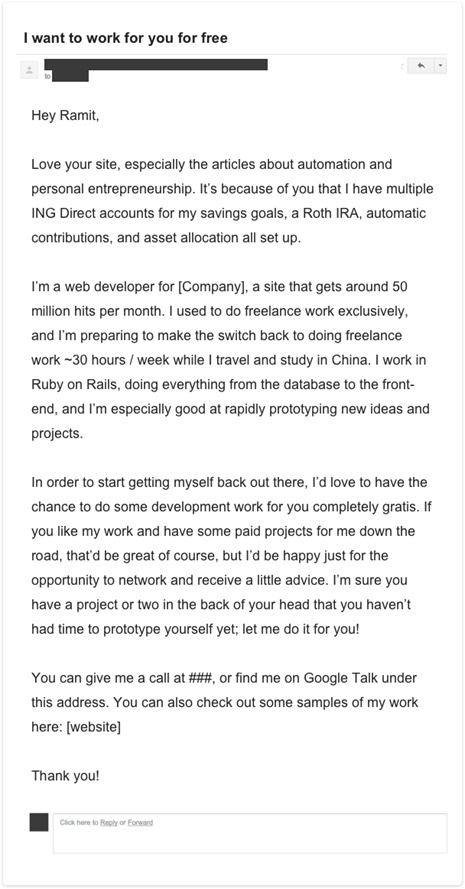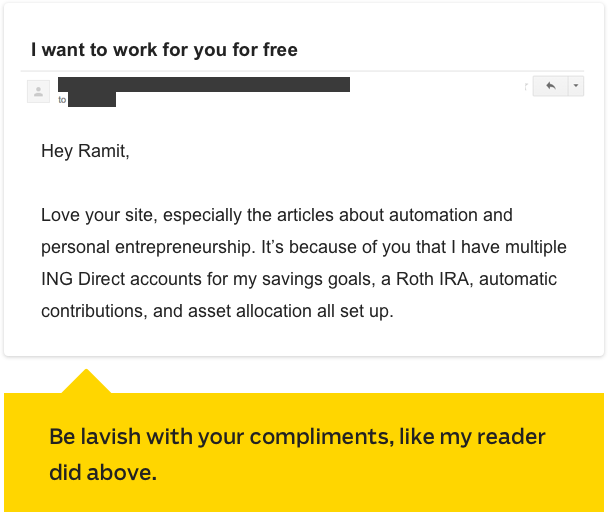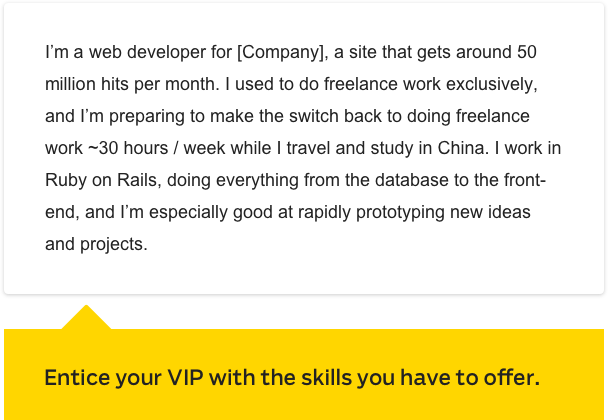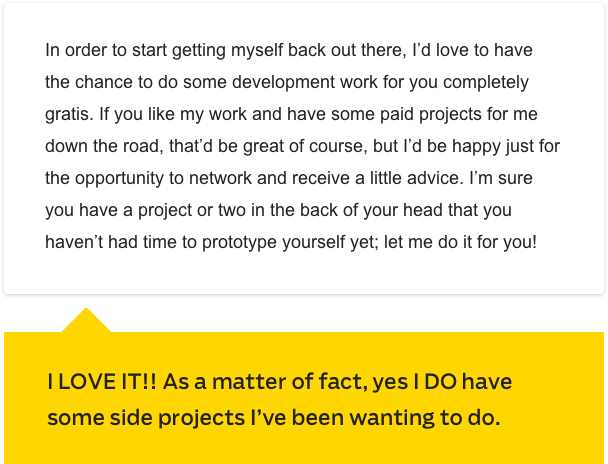I want to show you an actual email someone sent me to ask for something that had me clamoring to call them.

With emails like these, I hope you appreciate the mental fortitude it takes to not go insane every day of my life.
But instead of just mocking the people who read my blog, I want to talk about the very best ones — the people who know how to politely reach out to VIPs and get a response.
The #1 key to asking for what you want politely
A lot of people think success is just a matter of “figuring it out” and reading a few books.
Top Performers know that they can leapfrog everyone else by getting personal advice from people who’ve already been through the fire. Ask any successful person how a mentor/advisor/expert has helped them, and they won’t be able to stop talking.
So how do you ask an elite level performer/VIP for help with something in a way that will actually get a positive response? Maybe it’s to get a recommendation for a job … or to get invited backstage to meet your favorite band … or even to get some advice on a tricky business situation.
The answer is to shift your focus from a “me” perspective to a “you” perspective. For example, years ago, I was hanging out with Charlie Hoehn, who’s worked with me and a lot of thought leaders like Tim Ferriss.
He told me how working behind the scenes has taught him about how to work with these kinds of people. “Everyone wants something from you guys,” he said. “Now I know how to stand out. Just don’t ask for anything! Actually add some value first.”
This “you first” approach is how I’ve been able to get the advice of best-selling authors, superstar CEOs, and all kinds of fascinating people.
Let’s take a look a look at that in action.
How to write a polite email asking for something
Here’s an email I received from a reader a while back. I called him within 60 seconds of reading it. See if you can find out why:

The reader was polite, considerate of my needs, and sold me on the benefits of working with him.
Let’s break down the anatomy of this email, though, so I can show you exactly why it works.
Step 1: Focus on the recipient

Remember: Your message to the important person should be focused on THEM. That’s the key to any polite email that hooks the reader in.
The reader above did this with a snappy and eye-catching subject line: I want to work for you for free.
YES. You have my attention.
He goes on lavishing me with compliments while sharing an example of how my advice has helped him.
What do you notice about that? It’s a genuine compliment. He’s not giving me superficial niceties like, “Your blog is cool” or “Awesome videos!” He says he has multiple ING Direct accounts, a Roth IRA, and an automated finance system set up because of me. THAT’S how you write a polite email.
Use the first one to two sentences to compliment the person you’re emailing and their work. Tell them how long you’ve been following them, what their advice has done for you, and/or your favorite post by them.
This will hook them into reading the rest of your email.
Step 2: Sell your benefits
Let’s face it, you’re trying to sell yourself here.
What benefits can you offer them? Why should they care?
Sometimes this comes in the form of a warm contact (more on this later). If you know of a mutual connection, you should name drop so the person you’re talking to knows how you know them. They’ll be much more willing to work with you if you both know the same person.
For this email, my reader knew that I was looking for talented developers — so he sold me on that.

Guess what? That immediately set him apart from 99.999% of the crowd.
You’re going to have to do your homework if you want to leverage this technique. You need to know your VIP’s pain points and how YOU can solve them.
Go deep. Get inside of their heads. See what solutions you can offer to their biggest problems.
Be like Don Corleone.

Notice that they’re ramping up their YouTube presence and you’re a video expert? Tell them that and do it for them.
Can you take their social media game to the next level? Sell them on all the followers and traffic you can generate for them.
If you can’t come up with a specific solution, show the person you’re emailing you have XYZ skill that’ll have ABC benefit for them.
Step 3: Make saying “no” impossible
Your last step is to anticipate any objections or concerns they might have.
My reader knew I had a few projects I wanted to get to but hadn’t made time for them yet.

And while I could tell he really wanted paid work, he tells me that he’d “be happy just for the opportunity to network and receive a little advice.”
This made me saying no to him impossible!
He respected the power dynamic. After all, he reached out to me asking for my time.
And he showed this by being proactive, offering up his phone number, and also providing samples of his work from his website.
Also acknowledge how many emails they get by ending your email with this script:
“I understand you have tremendous demands on your time, and if you don’t have time to respond, no problem. But if you do, even a sentence would mean a lot to me.”
This gives VIPs an easy out if they’re too busy. Counterintuitively, it also boosts your response rate since you’re showing empathy toward their time demands. Remember, this email from the developer worked so well, I called him within 60 seconds of receiving his message.
Follow these steps, and you can see the same results.
I then encourage you to use the Closing the Loop Technique to follow up with your VIP two weeks after you get your response. You can use the following script:
“Hey, you told me ABC. I dug in. I discovered you were right, and so I took your advice and I just wanted to thank you. I’ll keep you updated a couple months from now about how the new XYZ is going.”
ACTION STEP: Contact your VIP
- Brainstorm ONE busy VIP you’d love to contact, then shoot them an email.
- In the comments below, share your story and the response you got.
Now I want to show you the four traits all great email introductions share that’ll get you responses.
The traits are simple — but 99% of people skip them. Don’t do this.
Trait #1: Reaches out through a warm contact.
As mentioned before, you’re going to have a better chance of someone responding if you name drop a mutual contact.
Why? This gives you social capital. If you know the same awesome people they know, they’ll want to work with you. Simple as that.
Even if you don’t think you have one, I HIGHLY suggest you search anyways. The results might surprise you.
Some good resources to check for mutual contacts:
- Facebook (Use the site’s mutual friends tool to see who you know in common)
- Twitter (Check out who they follow. Do they follow and engage with anyone you know?)
- LinkedIn (Leverage the site’s mutual connections tool to see who you both know)
- Their blog posts
- If they wrote a book, check the “Acknowledgements” page
Over the years, people have found mutual contacts with me through ALL of these resources.
Trait #2: Explains any similarities we have.
This trait can automatically establish a connection with the person you’re emailing even if they’re a complete stranger.
Some examples of areas where you might share similarities:
- College
- High school
- Hometown
- Company
- Industry
Even if you’ve never met, if you both went to the same high school or are from the same town, you both immediately have shared experiences. This is powerful and crucial when getting someone to respond to you.
If another Stanford alum reached out to me and seemed genuine, I’ll almost always take a phone call, or if convenient, a coffee meeting. It’s that powerful.
Trait #3: Cuts out the fat.
Check out this email I got a while back. It’s an absolute master class in bad email introductions.

Notice that in the second paragraph, he actually acknowledges that he should focus on ME (the busy person) … and proceeds to do the exact opposite!
On top of that, this was a very long stream-of-consciousness email.
Chances are, the person you’re emailing is probably very busy. As such, you’re going to want to make sure that your email isn’t wasting their time with any superfluous information.
Do that, and you’ll INSTANTLY eliminate yourself from their inbox.
Trait #4: Doesn’t outright ask for a favor.
This is something you should not do in an email introduction. That’s the opposite of polite.
Even if you’re just asking for help, it’s best if you provide the recipient an out so they don’t feel like you’re demanding something from them.
It’s always best to end an email acknowledging how busy they are and that they shouldn’t feel pressured into doing anything. Here’s a great script to do just that:
“I understand you have tremendous demands on your time, and if you don’t have time to respond, no problem. But if you do, even a sentence would mean a lot to me.”
See why that works? This gives your email recipient an easy out if they’re too busy. Counterintuitively, it also boosts your response rate since you’re showing empathy toward their time demands.
NOTE: The people who have reached out to me weren’t always the most socially smooth people. But the very best showed a remarkable level of preparation, which anyone can accomplish — but few actually do.
As a result, many of these people stood out among tens of thousands of others who left comments/emails/tweets. Not only do the very best Top Performers have an uncanny ability to reach extremely busy people, but they can turn a one-time meeting into a long-term relationship.
And over time, that is worth more than almost any technical skill or amount of experience.
Get what you want
I’ve just given you the five steps to asking for a favor and getting what you want. This strategy works for anything.
And if you want specific scripts for emails that get results too, I have five you can use to:
- Set up an informational interview
- Ask for recommendations for people to talk to
- Cold email a stranger for advice
- Pitch for a consulting gig or a job interview
- Reach out to others in your company to get to know them
Just enter your information below, and I’ll send you these five word-for-word scripts for free.
How to write a polite email asking for something is a post from: I Will Teach You To Be Rich.
Via Finance http://www.rssmix.com/
No comments:
Post a Comment